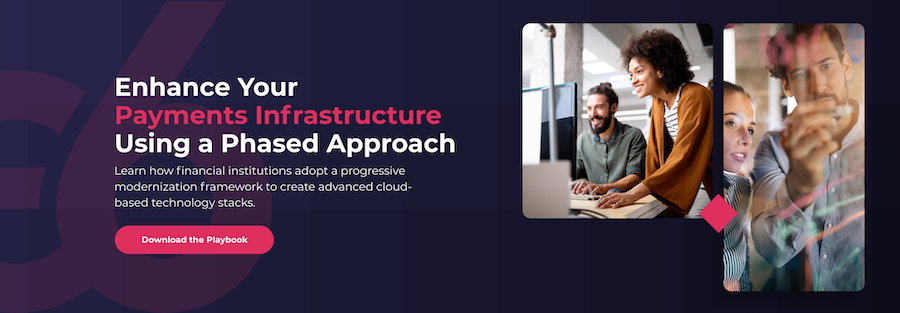7 questions to ask before modernizing your banking platform

Today’s financial landscape is falling behind the demands of consumers. Users who require quick and easy transactions are often let down by legacy payment technology. By assessing their current banking platforms, financial institutions (FIs) can determine which aspects need to be improved and how best to approach the transition process.
Pains of legacy technology
Payment methods are not what they used to be. Instead of handing over cash, technology innovations are making payment systems fast and easy to use. With smartphones, users can pay for goods right at their fingertips. This highlights a key characteristic of today’s digital world: modernized tactics for a mobile society.
The legacy technology that many institutions still use is unable to keep up with the demands of modern digital banking. Today’s world is fast-paced, so new payment methods are meeting your customer where they are: with tap-to-pay, QR codes, and buy now, pay later options that are convenient for those on-the-go or looking to break up payment installments.

Additionally, maintenance and upgrades of legacy payment stacks are costly to execute. Instead of software alterations, these systems require unique on-site skills that are becoming harder to find as the demand for IT professionals increases. Paying for these talents poses a large burden on companies that remain stuck with old technologies.
By 2030, IDC estimates that 74% of consumer payments will be conducted by non-traditional providers. This falls in line with trends we’ve seen regarding a transformation in payment technologies. To satisfy the needs of an evolving financial landscape, banks need to modernize their tactics and step away from traditional payment practices.
Questions to ask before modernizing your banking platform
Improving your payment processes requires careful planning to ensure a successful transition. Before fully transitioning your FI to a modern banking platform, consider these questions to help limit any challenges along the way.
1. What is your current banking infrastructure?
Conducting an analysis of your current banking platform will provide insight into challenges you might be facing that can be addressed by the upgrade project. With an understanding of your objectives, your team can determine areas to be prioritized. This might include an investigation of payment terminals and security capabilities.
2. How will this upgrade help you to better serve your business?
Consider how an upgraded banking platform can improve your business operations across multiple features.
Improve service for your customers
Customers are living in a digital-centric environment, and banking practices need to reflect that. Between mobile wallets and modern point-of-sale technology, users expect all transactions to be seamless. Upgrading banking platforms allows FIs to provide simplified payment methods that satisfy the mobile demands of their customers.

Increase security
Legacy systems often fall victim to hackers trying to gain access to customer records. Since 2018, FIs have encountered more than 153 million leaked records as a result of data breaches. With advanced technology, banks can enhance their security controls to protect customer information and stay ahead of other competitors.
Improve efficiency
Slow software can become a huge source of frustration among both customers and employees. Inefficient systems can hinder productivity and limit revenue as they are unable to complete transactions at the same rate as modern technology. With the implementation of modern digital banking platforms with automated processes, FIs can provide high-quality service at a much faster rate.
3. What are the risks associated with the project?
Anytime a bank makes changes to their technology there will be risks — that’s unavoidable. However, understanding the threats associated with a transition to modern technology can help determine ways to limit them.
When replacing a bank’s core technology, there are going to be more risks connected with the project in comparison to a progressive modernization approach. A total replacement can require expensive technology, and finding the right professionals with adequate skills is increasingly difficult.
A complete turnover of traditional banking platforms in one large sweep provides more room for errors to occur. With a slower transition process to modern payment platforms, extra care can be taken toward accurate functionality.
4. Are there any regulatory or compliance issues you need to address?
Digital banking regulations are not the same as they were decades ago. The growing trend of online platforms requires new compliance standards to protect the sensitive data of FIs as well as their clients.
Regulations in regards to local data protection are often incorporated into modern banking systems. Obtaining appropriate licensing is an essential step toward a modern banking practice that meets the needs of consumers. When selecting a modernized upgrade approach, it's important to be aware of your current processes and how they may be integrated with new technology while maintaining compliance standards.
5. Who will manage the project and provide support once it's completed?
While many modern techniques for banking management are automated, they still require a degree of human touch. Conduct an evaluation to determine who will be responsible for the management of your modern banking platform. This might include an IT professional, a leadership member from your organization, as well as a sponsor from the vendor.

6. Is there a timeline for completing the project?
The transition to a modern payment technology stack will take some time, but that reduces the threat of risks. According to IDC, this whole process may take five or more years before it is fully completed. Work closely with your team to determine how much time you are able to contribute toward this project before moving forward.
7. How much will it cost to implement it from start to finish?
Addressing your resources is a key step in identifying the right migration process for your needs. Between vendor management and employee assistance, determine how much money your business is able to allocate toward this project. The cost of the project will vary depending on the size of the integration needed.
Modernize your banking platform with the help of E6
Progressive modernization is an effective way to improve current banking practices in order to meet the demands of your customers. E6 offers innovative cloud-based solutions to incorporate a modern approach to banking that is no longer satisfied by legacy technology systems.
Cloud functionality provides users with customized and automated approaches to their banking needs while staying agile in an ever-growing digital environment. Here at E6, we are a global provider of enterprise-grade payment technology and ledger management infrastructure for banks that need to keep pace with disruptors and evolving consumer preferences
Tritium®, our PCI-compliant core platform, is 100% cloud-based and accelerates digital transformation by removing the limitations of legacy technology and enabling our customers to drive the future of payments.
To learn more about the progressive modernization approach to improve your banking experience, get in touch with an E6 team member today!

E6 Team
About the Author
Episode Six provides financial institutions with solutions for legacy payment stacks that aren’t fulfilling the needs of an expanding industry. We are a global provider of enterprise-grade payment technology and ledger management infrastructure for banks that need to keep pace with disruptors and evolving consumer preferences.

